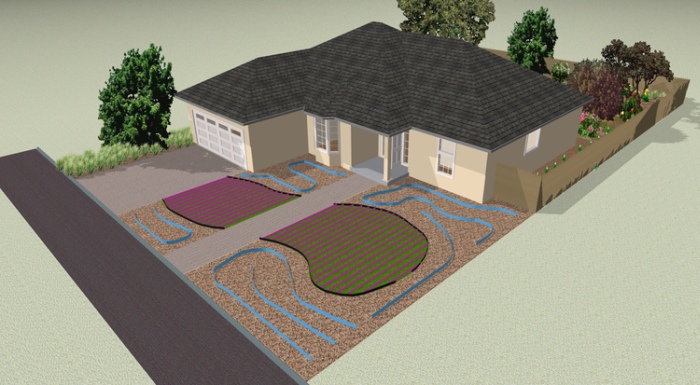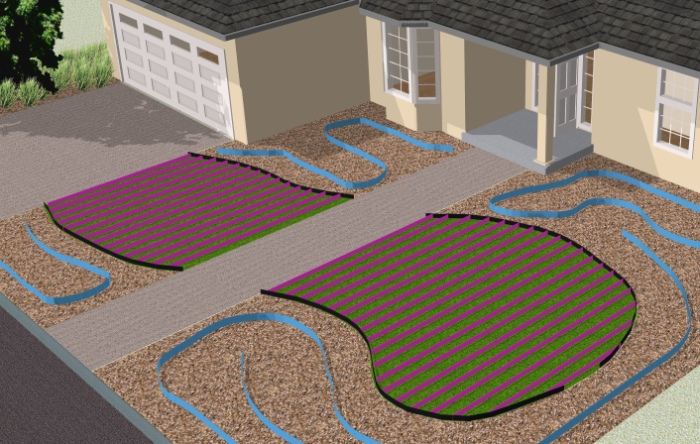Irrigation
- Resident's Guides
- How IrriGRAY Works
- Set up your system in 3 easy steps
- Do's & Don'ts with your waste water
- Viewing your data via the internet
- Privacy and Your Data
- Installation Guides
- Overview
- Plumbing
- Electrical
- Irrigation
- Contractor's Guides
- Overview
- Managing Installation Configurations
Irrigation
The IrriGRAY collection and pumping basin has a small footprint and is not designed for volume storage. The small footprint keeps manufacturing and installation costs as low as possible, as well as virtually eliminating large tank issues such as settling of sediments and odor buildup.
As an instantaneous pumping system, it is critically important that zones sizes are set to enable balanced inflow to outflow. Because most residences produce graywater between 5 and 10 gallons per minute, irrigation zones should also be sized to allow 5 - 10 gallons per minute flow rate for irrigation.
Landscape Bed Zones

This image shows a typical combination of landscape bed and turf irrigation layout.
The blue lines represent landscape bed dripperline, laid on the soil surface but covered with 2" of mulch / decomposed granite (or similar).
The purple lines represent sub turf irrigation. The black lines are the header and footer lines for the sub turf dripperlines.
The recommended dripperline for Landscape Beds is IrriGRAY 2.0 GPH dripperline with emitters at 12" spacing.
The flow rate for 300' of dripperline = 300 (emitters) x 2.0 (flow rate per hour) / 60 (minutes in an hour) = 10 gallons per minute.
- The ideal total length of dripperline for a landscape bed is 200' to 300' (6 - 10 gallons per minute)
- The maximum recommended length is 450' and the minimum recommended length is 150'.
IrriGRAY dripperline is installed on top of the soil, covered by a minimum of 2" of mulch, decomposed granite or other suitable material to avoid human contact - as required by virtually all graywater codes.
Small Landscape Beds
Because Capillary Irrigation Effects move the graywater sideways through the soil, landscape beds usually only require a single dripperline straight down the middle of a bed up to 5 feet wide - because we are watering the soil, not the plant.
This could cause a problem if the landscape bed/s are not very long. For example a collection of landscape beds that are only 5' wide with a total length of 100'. With normal irrigation zone planning, this would only require 100' of dripperline, but this is less than the recommended minimum length, and could result in loss of graywater to overflow if two showers are running at the same time, producing 10 gpm while the zone can only irrigate at 3.3 gpm.
The solution is to add extra dripperline, either by doubling up the dripperline, or by snaking the line to use at least 150' within the bed.
Extending the dripperline length DOES NOT increase the amount of irrigation - it just means the water can be irrigated faster. IrriGRAY uses a water flow sensor / meter that ensure only the water required to suit the defined zone surface area, planting type and current season is applied.
Turf Zones

Although Capillary Irrigation Effects do move water sideways through soil, turf must have sub surface dripperline every 12" to ensure even green growth. If dripperline was laid out sparsely e.g. 24" apart, green and 'not so green' visual striping would occur.
The recommended dripperline for turf is Netafim Bioline 0.6 gph with emitters at 12" spacing, regardless of soil type. This specification has been agreed with Netafim and overrides other published literature.
- Water is supplied to one side of the dripperlines via a 3/4" poly line header.
- The other end of the dripperlines are connected to a 3/4" poly line footer.
- A vacuum break / anti-syphon valve is added to the footer. This prevents 'suck back', where negative pressure inside the dripperlines when pressured supply stops could 'suck back' water and dirt from outside the dripperline back inside.